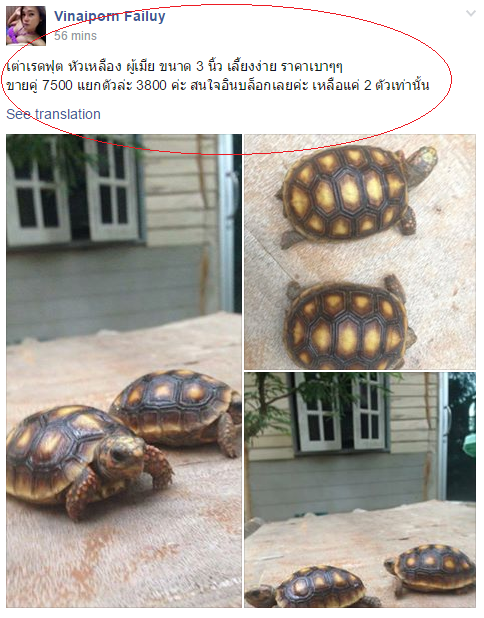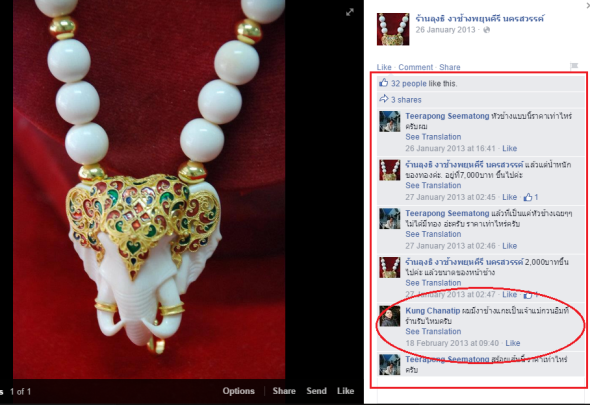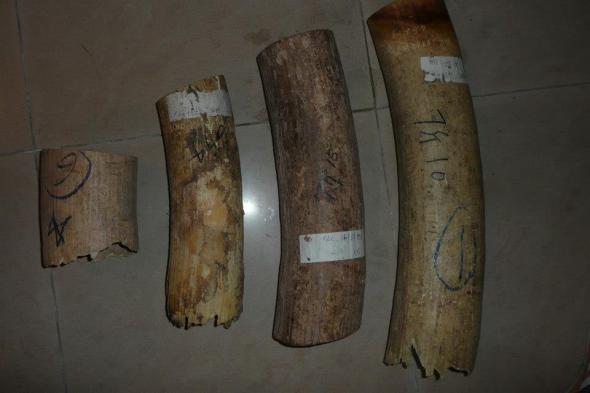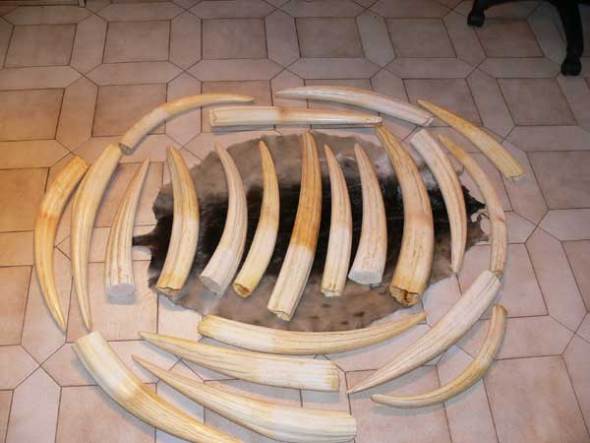SHOULD VIET NAM BE SLAPPED WITH TRADE SANCTIONS? | ILLEGAL WILDLIFE TRADE.
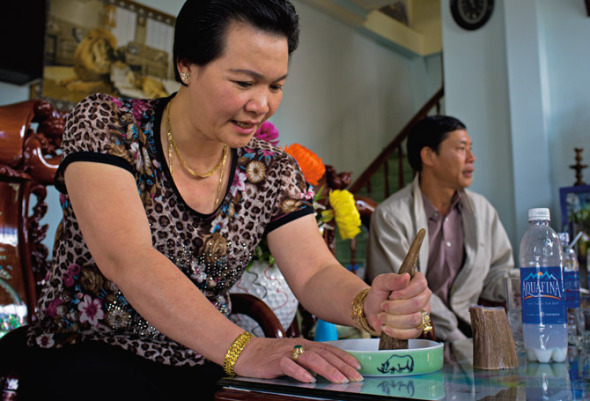
SHOULD VIET NAM BE SLAPPED WITH FULL TRADE SANCTIONS?
Since 2012 International Animal Rescue Foundation Africa’s (Cyber and Environmental Crimes Team) have been investigating Viet Nam’s illicit and illegal wildlife trade more closely than we’ve ever done. Back in January 2015 I Dr Jose C. Depre the (CEO) ordered a meeting with both units from the Environmental Cyber Crimes Team and External Affairs Unit); both focusing on the ground and online trade of illegal wildlife contraband. My aim was to increase both online and ground team investigations to begin breaking the back of these ruthless criminals throughout Asia and Africa.
International Animal Rescue Foundation Africa since founded have conducted 1,033 investigative surveys relating to all areas Viet Nam’s illegal wildlife trade (online and ground trade). However it wasn’t until January 2015 after uncovering a colossal rhino horn trafficking ring within Thailand and Viet Nam that we eventually decided Viet Nam had to be investigated more in-depth - all of which has resulted in a number of arrests and confiscation orders this year alone. The ongoing investigation was ordered due to a suspicion that the illicit ivory trade was increasing in Viet Nam too. Furthermore various organisations, media and press had stated that Viet Nam’s wildlife trade was actually decreasing, neither of which was true!.
I.A.R.F.A’s investigations aren’t just focused on Viet Nam. Specialist teams locate traffickers, suppliers and even poachers. These highly trained investigative officers move from one country to the next discretely monitoring and following various traffickers and kingpins (not forgetting befriending others too - which in many cases can be quite dangerous). While most of our investigations have focused primarily on Viet Nam, China, Thailand, Laos, Japan and Malaysia. Investigative officers have also been working within Uganda, Angola, South Africa, Namibia, The Democratic Republic of the Congo, South Sudan, Niger, Nigeria and Burkina Faso (among many other countries).
In four days time South Africa will be hosting the next Conference of Parties (CoP17). The Convention on International Trade in Endangered Species of Wild Flora and Fauna (CITES), that now hosts some 184 CITES signatories which will be debating numerous issues relating to both flora (plants) and (fauna) animals. The meeting will take place from the 24th September to the 5th October (2016). Back in 2011 Interpol estimated the extent of the illegal wildlife trade between $10 billion and $20 billion per year. This figure has gradually increased since 2014.
The illegal wildlife trade isn’t confined to just one country. Many countries around the world host wildlife trafficking and dealing routes extending to every continent. Conservationists say the problem is most acute in Southeast Asia. There, trade linkages to key markets in China, the United States, and the European Union; lax law enforcement; weak border controls; and the perception of high profit and low risk contribute to large-scale commercial wildlife trafficking. The ASEAN Wildlife Enforcement Network (ASEAN-WEN) ASEAN Wildlife Enforcement Network, supported by the U.S. Agency for International Development and external funders, is one response to the region’s illegal wildlife trade networks.
Figures from 2014-2015 have shown a startling increase relating to the funds generated from the illegal wildlife trade. Today illegal wildlife trade is estimated to be worth US$50-150 billion per year. The global illegal fisheries catch is valued at US$10-23.5 billion a year and illegal logging, including processing, at US$30-100 billion. (Source: Illegal Wildlife Trade 2014-2015). So as one can see no matter how many meetings we’ve been holding the illegal wildlife trade is skyrocketing to levels that we’ve never seen before. The question is though, how do we as environmentalists stop this, how can we force violating countries to take notice?
International Animal Rescue Foundation Africa have been calling on CITES for more than five years now to impose trade sanctions against offending countries. Unfortunately CITES and their signatories haven’t in our opinion taken a blind bit of notice, especially when it comes to Viet Nam that has been blacklisted as ‘possibly the largest threat to global wildlife on the planet?’. A trade sanction (which is what we want placed against Viet Nam and other offending countries) is a trade penalty imposed by one nation onto one or more other nations. Sanctions can be unilateral, imposed by only one country on one other country, or multilateral, imposed by one or more countries on a number of different countries. Often allies will impose multilateral sanctions on their foes.
From 2015 we (the organisation) have located a staggering $13.5 million (USD) of illegal wildlife contraband - most of which is being traded online via various forums such as Facebook within secret groups. (You can view a some of the contraband we investigative via our Facebook page here). On speaking to numerous traders to try and understand why this trade was being conducted on line; the traders have always stated: (Its more safer to trade, they can trade to a wider market without the need to carry their products over many miles. Finally, its quicker to trade into large private buy and sell forums anything that would be deemed ‘hot to handle’ such as Rhinoceros horn, elephant ivory, and pangolin parts (Etc).
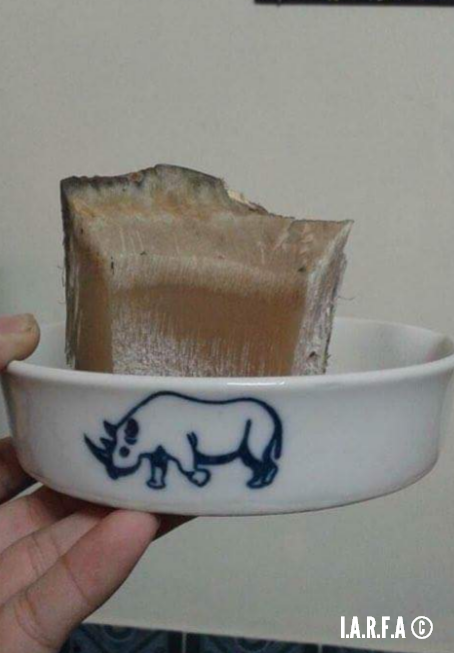
Image: Mr Tuan advertises the authenticity of recently smuggled rhino horn 11th August.
I.A.R.F.A have located over 21 African Rhinoceros horns traded illegally online and via ground markets since 2015 when we began our new anti wildlife trade operations and, 9 Indian One Horned Rhinoceros horns (all authentic). Mr Tuan, a Vietnamese national had no qualms whatsoever proving the legitimacy of his recently smuggled horn from South Africa. Anti Wildlife Trade Officers were invited to Mr Tuan’s Hanoi antiques shop of which in the back room were four recently poached Rhinoceros horns. I.A.R.F.A Anti Wildlife Trade Officers posing as interested buyers were offered the above in liquid form as a ‘so called aphrodisiac’.
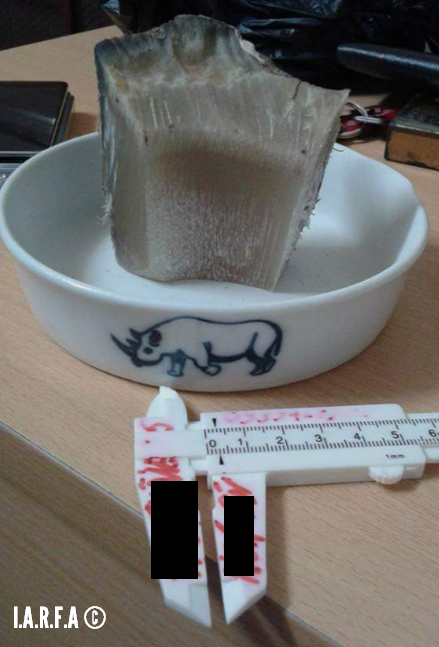
Image: Mr Tuan prepares to sell this horn to I.A.R.F.A investigators.
The above horn was measured up, weighed and offered to I.A.R.F.A investigative officers for a total of $4,000(USD). While the officers declined a small sample was purchased so that we could test the authenticity of this horn. Vietnamese investigative officers working with (I.A.R.F.A) the very next day took the sample to Viet Nam National University of which tests later revealed the horn originated from an African Rhinoceros based on the horns DNA.

Image: One of Viet Nam’s many Rhino horn kingpins. Mr Tuan.
While we don’t make a habit of exposing ‘wealthy wildlife trade kingpins’. As we’re nearing the (CoP17 summit) we believe its time to begin naming and shaming some of the dons behind this ruthless trade in order to communicate our message far and wide to all CITES members that enough is enough, sanctions must be placed against all violating countries. Mr Tuan doesn’t just deal in large quantities of authentic Rhinoceros horn neither. Ivory, pangolin parts and the critically endangered Indochinese Box Turtle also fill Mr Tuan’s home and antiques shop. So Mr Tuan if you’re reading please do say cheese.
Meanwhile Mr Tuan is just a small piece of the ever-increasing illegal wildlife trade iceberg. In one group that we’ve been monitoring for over two years that’s yielded 9 arrests thus far this year (which we cannot name for legal reasons). Some 33,000 individuals all over the globe are trading ivory, tiger parts, bear claws, pangolin scales and critically endangered moon bear skins (among many other items). The vast majority of these online traders that lead investigative officers to some ground locations are either Vietnamese, Chinese, Malaysian, Indonesian, Indian, Belgium, Australian, American and Canadian traders. One trader was even located in London W12, and two others dealing from Paris, France.
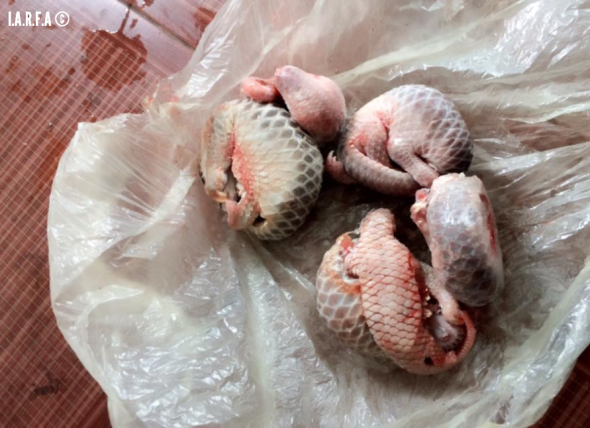
Image: Thailand smuggled endangered pangolins.
Rhinoceros horn is the least likely wildlife trade product that we come-by, simply because of its price, rarity, and the fact so many people around the globe are now putting their foot down relating to this animal part. Unfortunately its not just Rhinoceros horn that we witness being sold illegally online and on the ground. Mr Tu Su whom lives in Ha Tan, Viet Nam was clocked on the 19th August 2016 trading these smuggled pangolin parts online illegally.
Every year there are numerous arrests throughout Asia and convictions relation to pangolin poaching and trafficking, however no sooner is one dealt with - another smuggler and trader rears their ugly head, and can you blame them? All four Asiatic pangolins are now considered extremely rare to the point they’re nearing extinction. Furthermore as the species becomes more rarer - prices increase. These 6 pangolins were trading between $600(USD) and $1000(USD) each. Mr Tu Su has has quite a reputation relating to pangolin smuggling - so for the record below is Mr Tu Su’s face.
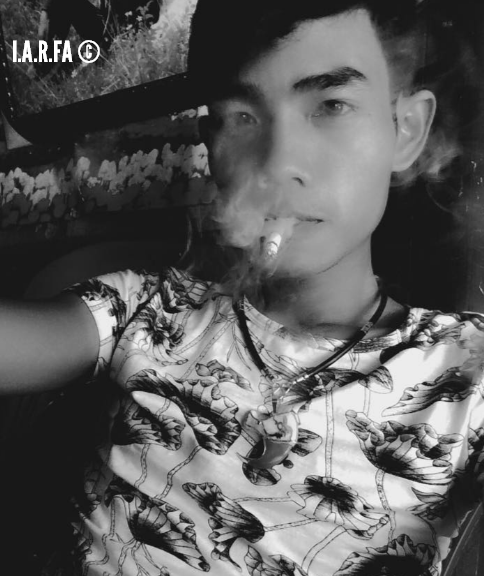
Image: Mr Tu Su - Pangolin smuggler and trader.

Image: Mr Tu Su - Pangolin soup.
All 8 species of Asian and African pangolins are ‘listed under Appendix II of CITES’, which means trade is regulated and monitored under CITES, (permits are required from exporting countries for any trade activity). To issue a permit, the exporting country must determine that this activity will have no detriment to the wild population.
As an additional protective measure, the CITES authority passed a (zero export quota for the four Asian species, which bans all commercial trade in these species). However, other purposes (scientific, research, etc.) can still be authorized by permit. For the four African species, there is no zero export quota, which means commercial trade is not prohibited, but permits are still required. Pangolins are also protected in their range states by domestic wildlife laws.
So Mr Tu Su if you’re reading then please note you’ve violated both domestic and international law, we’re holding your details too!
International Animal Rescue Foundation Africa have increased investigations relating to the illicit wildlife trade. Our two main areas of focus is that of the Rhinoceros horn trade and the ivory trade. Since 2015 our investigations surrounding the illegal ivory trade (have located a staggering $6 million(USD) of ivory smuggled from Africa into Thailand, China, Malaysia, Singapore and, Viet Nam.
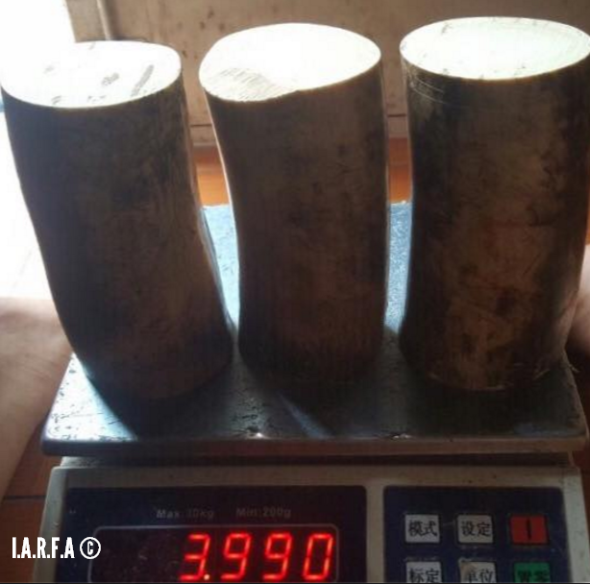
Image: Ivory trafficked from Tanzania onto Viet Nam.
Ivory trader and trafficker Mr Ban Me from Buôn Ma Thuột, Đắc Lắk, Vietnam was observed on the 16th August 2016 trading the ivory above online in one of three secret Vietnamese and Chinese ivory trading online forums. The ivory above is estimated to be around $6,500-$8,000(USD) for the lot.
Mr Ban Me makes no effort to conceal his lucrative online trade neither. When investigating this trader and trafficker we went back through many months of posts within the secret forum, then managed to locate Mr Ban Me who is aged around 35-30 years old. On locating the trafficker/trader it appears from the online evidence that ivory is coming in quick, measured up and weighed, of which either himself or friends then soon after set about to carve the ivory into jewelry.

Image: Ivory measured up and weighed for sale and carving.
Since January 2015 (International Animal Rescue Foundations) Environmental Crimes Officers have underneathed new trading trends relating to the ‘online wildlife trade’. As explained in previous articles most traders nowadays will take delivery of illegal wildlife contraband. From there the wildlife parts are then photographed (as seen in the image below). Traders will either then set up a ‘pseudo Facebook profile’ or already have one in place. The Facebook profile will act as a mobile online shop.
Most traders and traffickers we’re investigating today use this method of online illegal trading. They know by using a throw away or cheap (non-traceable cell phone) that any chance of them being located is slim. Traders are rarely seen selling in bulk on the streets of Viet Nam or over the borders in other Asian countries. Buyers and traders feel safer trading, swapping or trafficking items uploaded to the internet.
Mr Ban Me takes delivery of a large quantity of ivory every month from Africa, most of which has been illegally trafficked into China. Once carved the items are then photographed again to sell online within secret trading rooms to hundreds if not thousands of people. The ivory seen above and below was ‘advertised’ to an audience of over 33,000 individuals.
So as you can see its incredibly difficult for us or any investigate organisation to track in quick time where these products are originating from and ending up. Traders use these rooms online because they know selling to a wider-ranged audience products can shift quickly. Unfortunately for Mr Ban Me we have his contact details, his address, his cell phone numbers, and even know who is selling too and buying from.
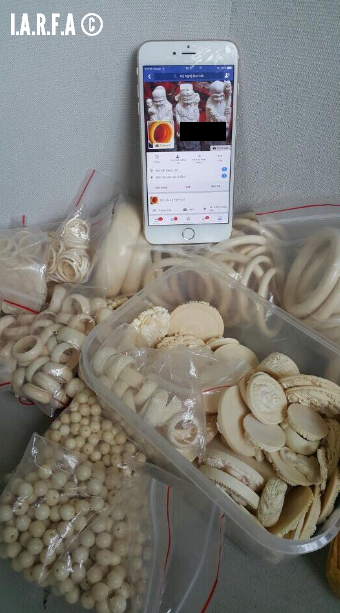
Image: Carved ivory on sale from the tusks observed and intercepted online.
Another shocking ‘concern’ is that Mr Ban Me ‘could be purchasing ivory from Thailand elephant traders’. I.A.R.F.A have known for many years now that ivory tusks are being shaved down from Asiatic elephants. A trace of Mr Ban Me’s cell phone images revealed further evidence that showed himself photographing Asian elephants onto his ‘Facebook ivory profile’. Should this be true - it will prove to be further damning evidence that elephants are being exploited within Asia for the ivory trade on a much larger scale than previously documented.
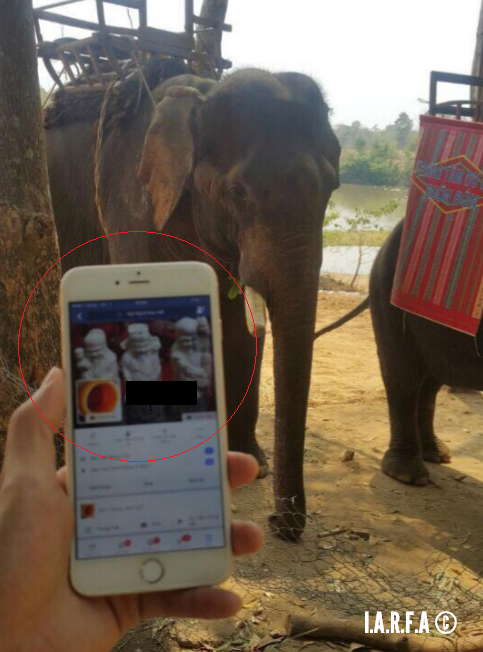
Image: Ban Me photographs Asian elephants onto ivory Facebook profile.
The only image we have of Mr Ban Me is that of his wood workshop in Viet Nam (pictured below). The entire Facebook profile (like many thousands more we have and continue to observe) depicts that of ivory and few rose wood products. The question is though - who’s supplying this young Asian man with ivory? I.A.R.F.A have demanded that Facebook and the F.B.I take action against this illicit trade, and even supplied the Social Media platform with an 11,000+ petition signature however as yet nothing is being done to combat this trade?
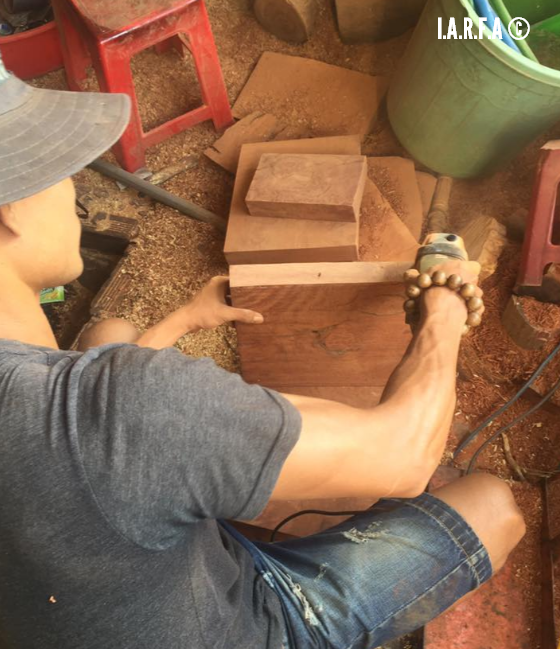
Image: Mr Ban Me carving wood in Viet Nam. where ivory is also traded.
Back in December 2015 International Animal Rescue Foundations (Environmental Crime Officers) passed hundreds of pages of evidence onto international law enforcement agencies and Interpol relating to illegal wildlife traders. There have been numerous arrests due to our investigation and, from that investigation other individuals have been looked into resulting in new investigations and arrests too on a global scale. However no sooner is one trader stopped - another one pops their ugly head up from the sand and begins trading.
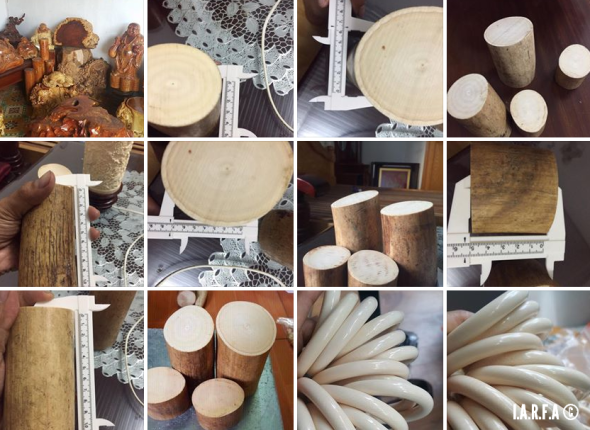
Image: Mr Ban Me’s ivory Facebook shop profile - ivory tusks, and carved ivory jewelry.
A further trader that ‘openly admitted to I.A.R.F.A Environmental Crimes Officers tried to sell these tusks (pictured below) to an I.A.R.F.A investigator. Going under the name of Mr Thường, from Hanoi Viet Nam, he like Mr Ban Me made no effort whatsoever to conceal his hoard of illicit ivory - most of which was from African elephants. Furthermore he too like Ban Me had created a ‘pseudo Facebook profile to trade illegally elephant ivory’.
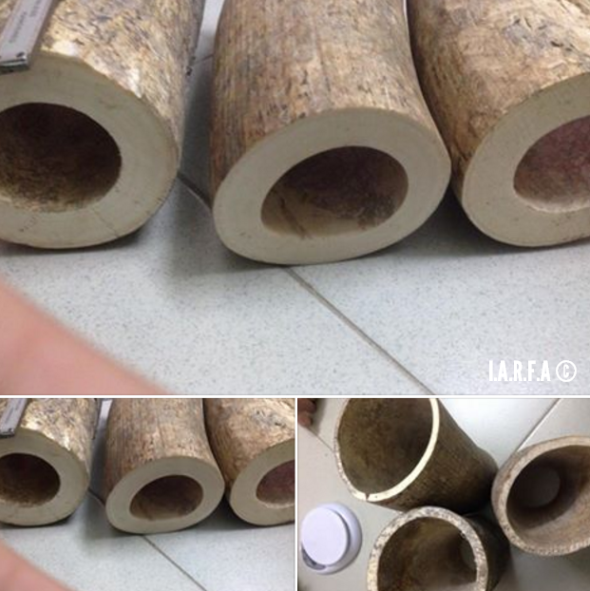
Image: One of many thousands of online Facebook ivory trading profiles.
Viet Nam banned the ‘domestic ivory trade back in 1990’. Furthermore there has been an ‘international ivory trade ban in place since 1989. Unfortunately while these bans have been in place - there are loopholes within some ‘countries domestic trades’ which permits them to trade ‘legally elephant ivory despite international and domestic bans’.
Furthermore ivory can to some extent be sold legally within Viet Nam should the products be antique or purchased before the ivory trade bans. However neither of our investigative officers have located any evidence to prove any of the ivory we’ve located was purchased/obtained legally before any bans were implemented. Damning evidence sent to law enforcement agencies around the globe also proves that ivory is being smuggled from Africa onto Japan and China then back into Viet Nam - Three countries known for their continued ivory trade violations.
While the ivory trade continues to rage out of control there are unfortunately many other illicit and illegal wildlife trades that are increasing within Viet Nam. I.A.R.F.A have noticed a very ‘alarming spike’ of bear parts, mostly moon bears for sale online and on the ground. Environmental Wildlife Crime investigative officers located this species [pictured below] - Ursus thibetanus on the 8th September 2016. The species is identified as the Ursus thibetanus and is listed as [vulnerable] on the (IUCN RED LIST) of threatened and near endangered species.
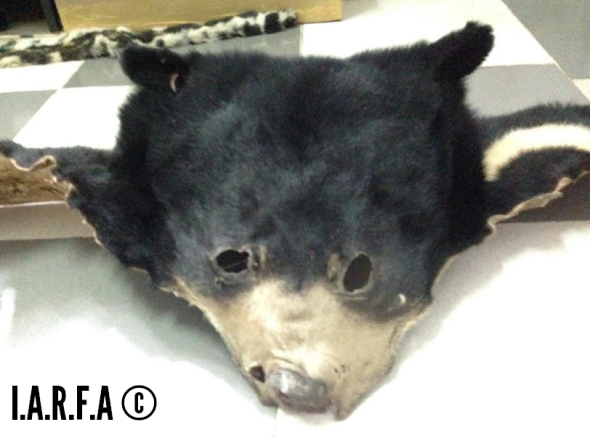
Image: Ursus thibetanus (Moon Bear parts) Viet Nam (2026).
Moon bear pelts, teeth, claws and bear bile are not exactly an uncommon species of animal to be located wihtin Viet Nam’s numerous medicinal markets, although its not common to view the species as it is above on sale within open markets. Bear bile has not decreased in sale on the TCM markets whatsoever in my humble opinion, in fact we (the organisation) hold very recent and damning evidence to prove that bear bile farming practices are sill very much operational. So damning that it does in fact bring many Non Profit Organisations into question with regards to their allegations of practically stopping this trade, when clearly its not being stopped!
Due to many counterfeit animal products on the markets, before any investigation is undertaken - Environmental Scientists will conduct routine examinations of purchased bear bile products to check their authenticity. These examinations are undertaken to store and maintain evidence files, to secure closures of illegal markets or, for further secondary investigations. I.A.R.F.A Wildlife Trade investigative officers located the following bear bile products on the market in Viet Nam.
A kilogram of farmed bear bile might cost $240, while the same amount from a wild bear could cost $15,730. Investigative officers were told the bile seen hereto in the image below was from wild bears, however we highly doubt it due to the lack of Asiatic black bears in the wild. Each bottle below was offered to investigative officers for just over $200(USD). I.A.R.F.A Wildlife Trade investigate officers did purchase three at a price of $600(USD) which is considered cheap. The ‘liquid was tested at the Nong Lam University of which proved to be 100% bear bile.
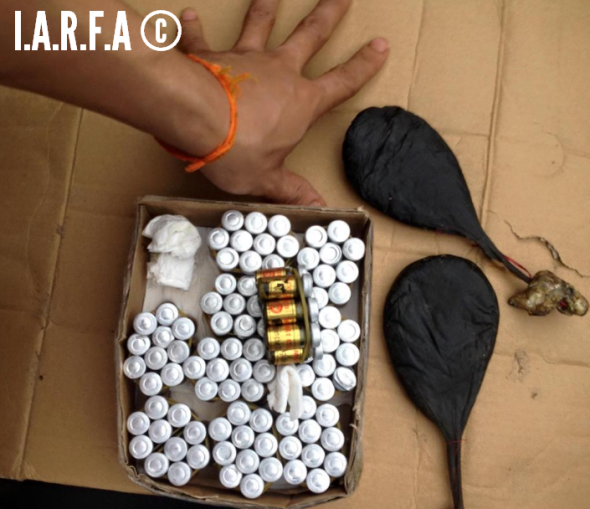
Image: Asiatic Moon bear bile in mass production with gall bladders.
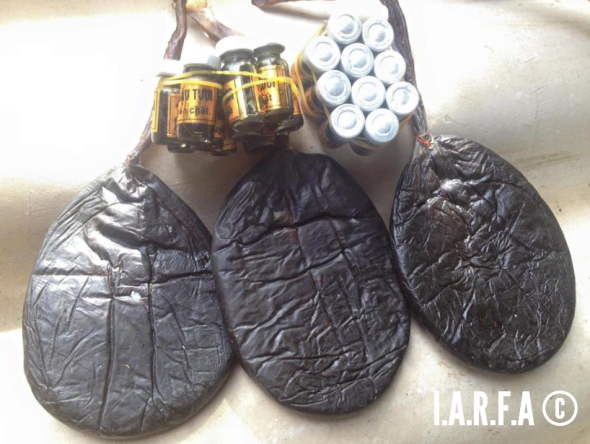
Image: Plastic wrapped gall bladders and bile.
Bear bile does not whatsoever hold any medicinal properties whatsoever, if anything consuming bear bile can actually increase health complaints. The barbaric practice is ‘illegal in China and Viet Nam’, Viet Nam banned bile production back in 1992, sadly the trade still goes on to some extent. Fortunately Viet Nam have stated they’ll be eliminating this horror come 2020, however we’re not holding our breaths just yet.
Mr Nheo who is aged around 21 years of age from the Huong District, living in Hanoi Viet Nam (pictured below) if you’re reading my friend you may want to stop trading pangolins, tiger parts, bear bile, tiger teeth, bear teeth and claws and ivory today. Bear bile hosts no medicinal properties whatsoever so why you’re trading this vile product - which leads to the destruction of bears for we don’t know..
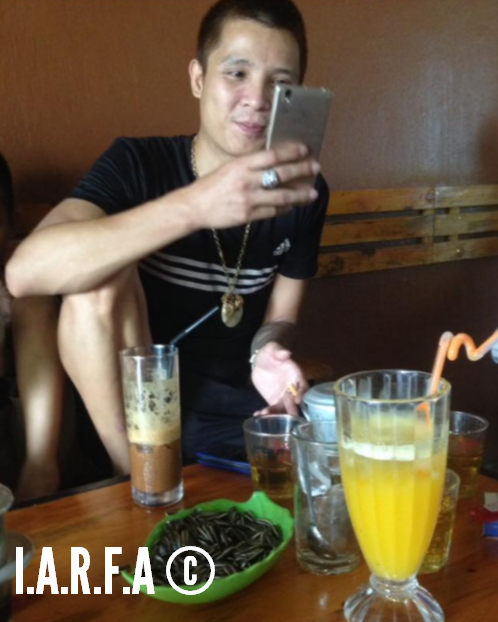
Image: Mr Nheo - Illegal wildlife trader from Hunong District, Viet Nam.
At the last Conference of Parties Summit (CoP15 - Thailand), Viet Nam made a promise to crack down on the countries illegal wildlife trade back in 2013. Although there was no actual deal made, Cites signatories did categorically state that should Viet Nam want any say in the ‘legalized international trade of rhino horn’ the country must clamp down on illegal wildlife trades and markets. I was at the last CoP summit of which Viet Nam agreed it was time to reduce their illegal trade markets - or face the consequences.
The whole purpose of this article and many others is to ‘highlight Viet Nam’s lies; the country hasn’t in my opinion made any progress to reduce their illegal wildlife markets, especially that of (critically endangered species). Yet Viet Nam has been identified as one of the leading countries to be approaching Cites for the ban to be lifted relating to the (international rhino horn trade). I ask myself daily - how is it possible for a country to control any legal trade if they cannot control the illegal trade of wildlife contraband?.
I.A.R.F.A. Environmental Crimes officers working online and on the ground furthermore have noticed a colossal spike in the number of tiger parts and dead tiger carcasses sold within Viet Nam’s illegal wildlife trade markets. The image below depicts a trader that is privately trading tiger teeth. While the quantity of tiger teeth wihtin the image (below) may seem small. I.A.R.F.A Environmental Cyber Crimes officers have been carefully monitoring this trader for well over a year. The vast amount of tiger parts he’s trading is out of this world.
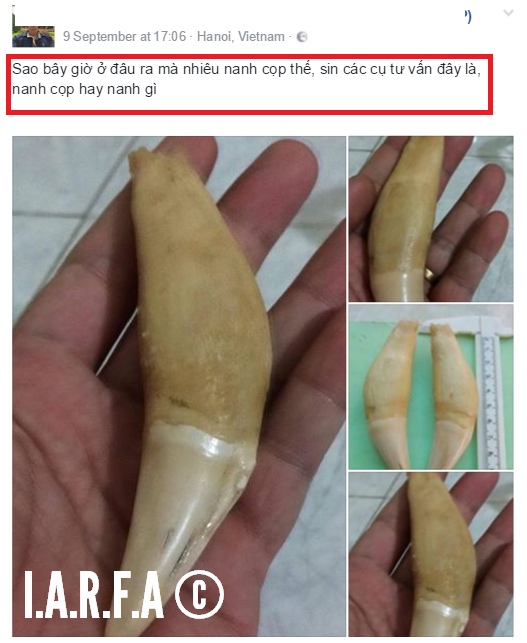
Image: Tiger teeth for sale- Online Secret Wildlife Trading Forum.
I.A.R.F.A have reported various tiger traders in Viet Nam to INTERPOL and local enforcement agencies. However as explained these bloody sickening traders, traffickers and animal killers continue to pop up time again. Most if not all the tigers that we are locating for trade (illegally) were ether captive tigers, smuggled tigers/parts from China and/or Thailand. While other specimens have actually originated from (pathology/veterinary universities inside of Viet Nam).
Three months ago I.A.R.F.A working with overseas enforcement experts concluded - the rare Asiatic leopard we located within a wildlife traders apartment had originated from a veterinary university in Viet Nam. Meanwhile the tiger skins/parts below have originated from Thailand. The question is though from where, who is supplying this amount of tigers and parts to traders within Viet Nam?
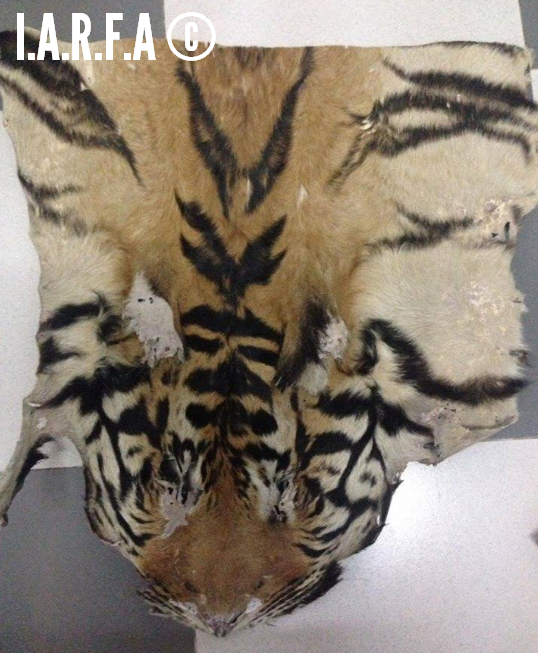
Image: One of many tiger skins offered to I.A.R.F.A investigators September 8th.
International Animal Rescue Foundation Environmental Cyber Crimes Officers was offered this tiger pelt for $1,060(USD). The trader that operates under the name of ‘Mr Coivodich’ also deals in ivory, threatened Rhinoceros hornbills, and bear bile. Furthermore we have been monitoring a very ‘concerning trend relating to tiger skin wallets. Captive bred tigers are slaughtered of which their skins are turned into wallets - a craze that is now becoming incredibly popular throughout Viet Nam. Tigers in Viet Nam are supposed to be bred for conservation purposes only. Clearly though from the images below this is not the case.
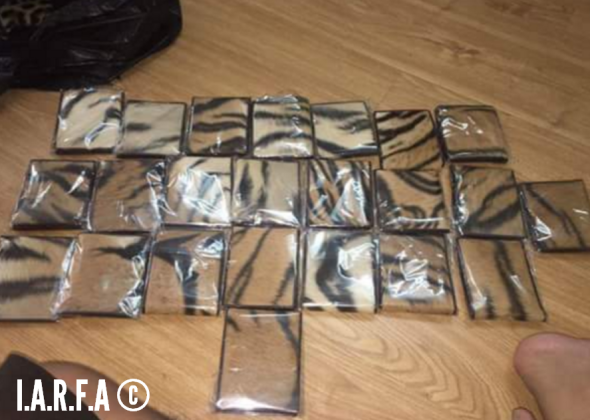
Image: Real tiger skin wallets packaged and ready for sale in Hanoi.
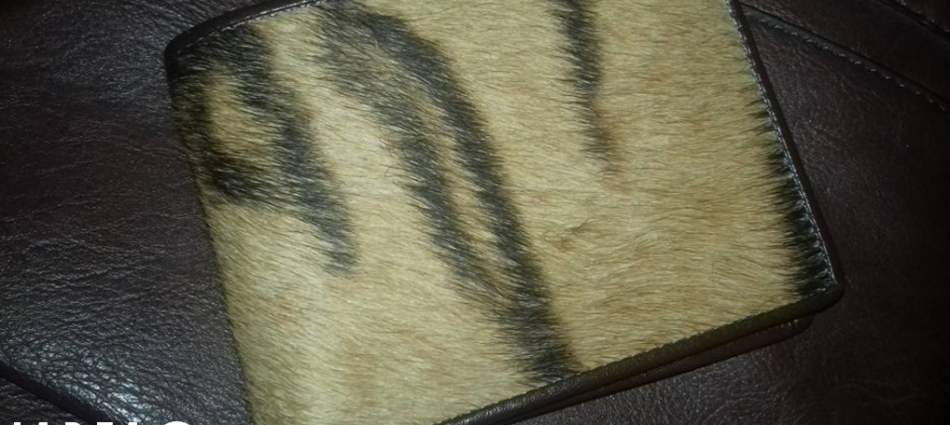
Image: Unpacked real tiger skin wallet, priced at $70.00(USD) each.
As explained tigers are supposed to be used for conservation purposes only. However we have located worrying evidence that makes Tiger Temple look more like a walk in the park. A famous Thailand Actor below is seen cuddling a drugged tiger at the Sriracha Tiger Zoo which we believed was a zoo inside of Viet Nam. (See image below). Unfortunately the tiger and this image eventually led back to Thailand, of which this zoo has been named as a horror ground. Would it be wise to assume that tigers are originating from this zoo and ending up within Viet Nam’s wildlife trade? We don’t know. What we do know for sure though is this zoo is now under close scrutiny.
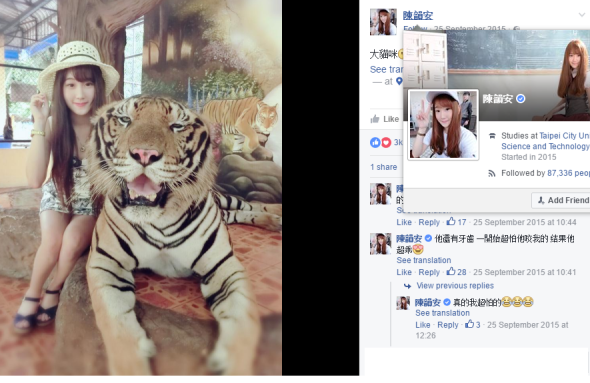
Image: Chen Yunan coaxes drugged tiger in Thailand.
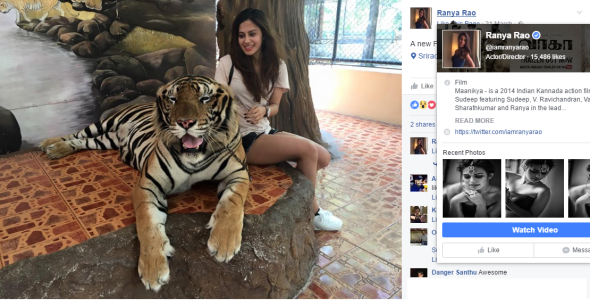
Image: Ranya Rao coaxing drugged tiger in Thailand.
International Animal Rescue Foundation’s Environmental Crimes teams have been working on our new anti wildlife trade project since 2015 being now the ninth major project that we have conducted in the past three years. Most of the evidence we are locating in relation to wildlife trade violations isn’t always within China - a lot of these violations are in fact within Viet Nam.
We are now under four days away from the next Conference of Parties (CoP17) to be held within South Africa, Johannesburg. CoP 17 has been set to be the largest summit held, and as such we may see countries such as Viet Nam asking Cites signatories to agree to a lift of the international trade ban in Rhinoceros horn. Every article that we’ve published in relation to Viet Nam shows the country cannot be trusted with relation to the international rhino horn trade. Every article we’ve published also shows numerous violations of local and international wildlife trade laws.
So the question remains. Is it now time to implement at CoP17 full part of full sanctions against Viet Nam to protect our local and international wildlife? I believe its now time. The evidence in front of you clearly shows Viet Nam’s refusal to act on their illegal wildlife trade markets. So how much more do we have to put up with before everything is eventually gone? Should Cites signatories lift the rhino horn trade ban we’ll keep to our promise. Being all those we know dealing in illegal wildlife products at high end market level will be named, shamed addresses published and that evidence released to the public. Video recordings, audio, images - everything.
The balls now in Cites court - Don’t underestimate us, we may be quiet - but we’ll stay quiet for only a short time before we begin naming and shaming.
Dr Jose C. Depre. PhD. MEnvSc. BSc(Hons) Botany, PhD(NeuroSci) D.V.M.
Environmental, Botanical & Human Scientist.
Facebook: Hotbed for Lucrative Ivory and Animal Sales.
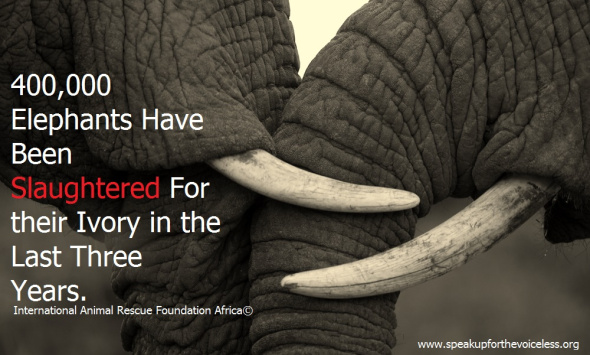
Since 2012 the External Affairs Investigations Unit (EAU), and International Animal Rescue Foundation (IARF), have unearthed a shocking trend of wildlife parts and tropical pet traders on the United States server platform of Facebook.
Operation Trojan Horse has been heading the ground-and-online hunt for traders then shutting them down via intelligence reports passed to the Police, Border Agencies and Internet Service Providers. The Intelligence gathering team state that Facebook is the new wildlife trading site whose technology conceals anything from pornography, murder, child abuse and in this case wildlife parts trade and the tropical pet trade.
Over the past several years we’ve seen a slow decline of wildlife-parts-traders and pet dealers as enforcement tightens around traders and smugglers bringing them to justice. Unfortunately, since as early as 2010 online trade has skyrocketed to new and worrying proportions. Traders intentionally use a textbook of keywords that fool Facebook’s bots and online surveillance teams, according to the External Affairs Unit [comprised of experts from ex-law enforcement officers, intelligence officers and computer experts.]
Investigative officer Tayah, who fronts the main online intelligence gathering team stated: “Firstly I begin by downloading a Virtual Private Network using pseudo details so that my location on G mail or Facebook cannot be traced. Then I have two options after signing up, creating a Facebook group or page. If say I wanted to create a group, I’d title the group using certain keywords to avoid Facebook’s bots and intelligence monitoring teams locating my network. From there I simply add trusted contacts and trade is on in under ten minutes. If I wanted to create a page, I’d again use set keywords and ensure that every country as possible remains banned from viewing the page. I then add say 50+ admins. Job done”.
Tayah makes it sound so easy but exposes a flaw: “Pages that use ‘country banning restrictions’ can still be located in the Facebook search bar. One just changes their Virtual Private Network (GPS) and you can locate anything from illegal porn, animal abuse, wildlife trading, pedophile rings down to dog fighting pages too”. Tayah went onto state: “Unless the user or anyone of the admins unpublished the Facebook page, intelligence gathering is then restricted to Facebook only. If Facebook administrators are unaware of these keywords or technology or are just lacking people power within the law-enforcement department then these ruthless traders will get away with anything”.
Working in conjunction with their Asian counterparts, IARF noticed most traders were deliberately concealing their video and image GPS as well. The problems don’t just end their either. Out of the 1.32 billion Facebook users, a staggering 32 per cent of users log in using a mobile device. One can turn the GPS off on a mobile device and download a Virtual Private Network. For all you know the friend your speaking to on Facebook that’s GPS states there from California in the United States, is really your best friend, wife, husband living with you or near you. That’s how lax Facebook’s online security is.
Tayah goes on to say “The fact I can access pages on Facebook using VPN software clearly shows Facebook is not as secure as it presents itself to be. While Facebook may have protected its millions of citizens, its allowed ruthless and very dangerous criminals to use the platform as a safe haven to buy, sell and trade in illegal animal parts, as well as children, which I’ve witnessed countless times from Russia to Karachi.”
A recent undercover survey uncovered traders selling Slow Loris within Thailand. Slow Loris are protected under Thai law and Cites law (see image below). Please click on all images to be taken to the real time evidence online. We’ve since filed the relevant reports for all and no longer require these images within our file. 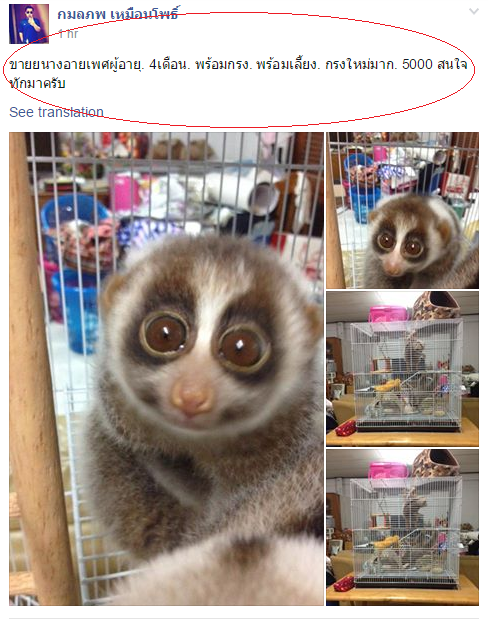
Image: ‘protected’ Slow Loris for sale on Facebook within a tropical pet group.
The trader (pictured above), is not bothered that the Slow Loris is protected under Thailand law. One species out of the five is listed as critically endangered while the remaining four remain listed as vulnerable. The tropical pet trade has been blamed on all five of the species gradually dwindling. Furthermore, Slow Loris despise being handled, brushed or kept as pets.
Slow Loris show a kind of not-bothered-look when being handled by humans. Unfortunately they cannot scream, like we do when tickled, brushed or bathed. Slow Loris hate being handled and do not make good pets. They are solitary creatures and also hate bright light. Yet Facebook has countless numbers of protected Slow Loris for sale, which is absurd, immoral and a slap in the face to conservationists and law enforcement. Is Facebook now above the law?
Facebook must be held accountable for this trade by implementing a ‘strict no wildlife or animal parts trade’ from species that are threatened within their terms and conditions. Should the United States platform not take the relevant actions then we may as well hang up our boots and go home. Frankly we’ve had enough of being ignored and fobbed off.
Endangered Tortoises can be located in many ‘Thai tropical pet and ivory’ trading Facebook forums. The image below depicts a Yellow Foot Tortoise, a species of reptile that isn’t endemic from the region of Thailand. Identified back in 1766 by Professor Carl von Linnaeus, the species is known as Chelonoidis denticulata classified as Vulnerable.
Image: Yellow Foot Tortoise are listed as vulnerable; Pet trade threatens their future.
Although not considered illegal to breed the species, EAU officers from Malaysia were mortified to know the breeder is importing the vulnerable species from South America. The unnamed breeder [not shown above], whom we cannot name, would not divulge how the tortoises are brought into the country but made it clear he could easily obtain more infants on demand, over the border from the wild.
Chelonoidis denticulata is an endangered species. The major populations located in South America are protected under the Convention on International Trade in Endangered Species, Appendix II. As with many species of Turtles and Tortoises, many Brazilian giant Tortoises end up as food items in local markets. This species of Tortoise is popular in the pet trade.
Despite the numerous specimens of endangered and nearing extinct tropical pets for sale on Facebook, one major concern is the illicit ivory trade. Back in 2013 IARF-Asia conducted a random survey within Thailand, aimed at active Facebook members of the public, both female and male from the ages of 16-21. 85% of respondents stated that they would not purchase, deal or trade in ivory and knew where ivory came from. The remaining 15% stated that they had traded, were trading or knew of relatives trading ivory and Rhinoceros horn.
We were skeptical to begin with because according to many third party reports, most whole tusks, or jewelry ivory sales appeared to be traded by adults rather than minors and teenagers. Researching Facebook from 2013 we not only discovered that Facebook was a hotbed for ivory sales - but the teenagers and minors whom IARF-Asia had questioned within Thailand were actively trading ivory online using Facebook. One trader, circled in red within the image below, brags he is trading ‘carved ivory’ within his shop, which later turned out to be his uncles shop (2013.)
Image: Ivory traders on Facebook 2013
Since re-examining the vast majority of respondents that originally stated they were not dealing with ivory, Facebook seems to have become a hotbed for ivory sales for figurines, pendents, amulets, down to large freshly carved tusks. IARF-Asia also noticed that since Thailand’s new leader, Prayuth Chan-ocha took over the country, ivory trade has increased to shocking levels.
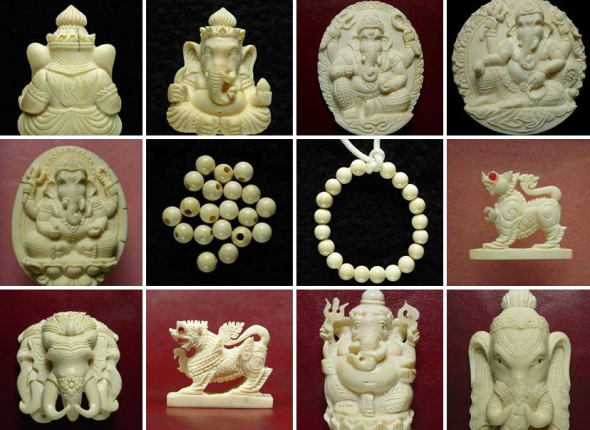
Image: Ivory Facebook profile set up as an online trade shop
Most traders will open up a Facebook account using words such as ‘ivory, ivory carvings, ivory trade, authentic ivory,’ etc. They will post photographs of some of their best selling items and then leave the page, group or their profile open for the public to view. Although the account may appear inactive, the trader silently monitors his account very closely because these profiles are created as mini shops for customers to purchase ivory pendents, charms, bracelets or carved tusks.
We are not only pointing our finger at Thailand or Facebook alone, despite Facebook seemingly unaware these traders are selling freshly carved and re-worked ivory illegally. Click on the image below and you’ll be taken through a Facebook group that is selling anything from Tiger bone wine, Bear claws and of course - ivory, in Viet Nam - on the United States social media platform.

Image: Viet Nam wildlife trading group on Facebook.
Not only insulting Africa’s heritage, but as a smack in the face to conservationists and a punch in the eye to law enforcement, one trader poses with an ivory carved Rhinoceros statue (pictured below.) Facebook is considered to be one of the largest hubs for illegal animal-parts trades that the EAU has located in years. Between 2012 -2105, IARF’s enforcement teams located multiple thousands of illegal traders openly and illegally flaunting Rhino horn and ivory.

Image: Rhinoceros figurine carved from poached ivory for sale on Facebook.
Shocked and in disbelief at the new findings by IARF’s intelligence teams, we wonder where have we gone wrong. Back in 2013-2014 a massive online enforcement campaign took place bringing down sites trading in animal parts, while Internet Service Providers (ISP) and online buy and sell sites took the pledge to not allow such items on sale. Unfortunately this has pushed many into the secretive and ‘secure’ platform of Facebook.
While there is continued demand and sale for illegal wildlife and animal parts, somewhere on the African or Asian continent an Elephant will be in the cross hairs of a poacher. The illegally poached animal’s body parts will be trafficked from Africa to Asia, then from user to Facebook, to meet the ever increasing demand that is sadly taking the social media platform by storm.
Within the past three years the Convention on International Trade of Endangered Species (CITES), stated some 400,000 Elephants had been slaughtered on the African continent alone.
There have been numerous large seizures of ivory and convictions of persons involved. Some countries are burning stockpiles of ivory to send a clear message to poachers and traders but despite these actions, the ivory trade continues. China announced in June of last year that enforcement teams had seized a total of 270 kilograms of ivory and Rhinoceros horn. Yet despite such seizures the trade goes on in the face of the law and as Facebook seems non-to-bothered some of the 1.32 billion users are using the platform as a trade and sell site laughing in the face of enforcement and conservationists.
In another shocking Facebook find, a routine search of Japanese traders revealed peddlers openly selling African Elephant ivory online. The shop (listed below), is set up as a hobby shop which works old and new ivory, creating pendents and necklaces, etc. The Japanese shop’s ivory belongs to Elephants which were illegally slaughtered on the continent of Africa, along with some re-carved antique specimens, which therefore continues demand and the illegal poaching. Please click on the image below, which will direct you to the Japanese Facebook page.
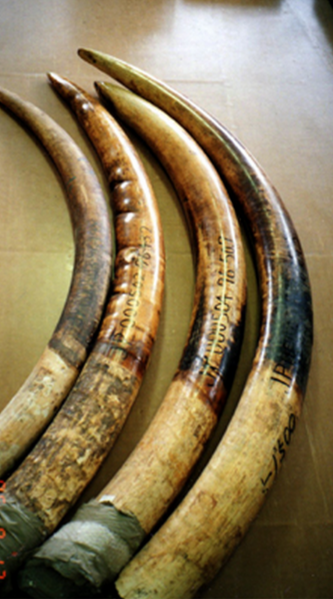 Image: African Elephant Ivory.
Image: African Elephant Ivory.
In April this year, Excellency Shinzo Abi was encouraged by major animal welfare organizations to cease trade in ivory and destroy any stockpiles being held in Japan. Since 1970, Japan has imported ivory from more than 250,000 African elephants, mainly from tusks that were illegally acquired through poaching wild elephants.
Japan has been granted permission twice to buy ivory, despite the UN Convention on International Trade in Endangered Species of Wild Fauna and Flora (CITES) 1989 ban on international commercial trade in African elephant ivory, which was adopted in response to the global elephant poaching crisis of the 1970s-80s.
In 1997, Japan secured CITES-approved ivory sales for nearly 50 tonnes of ivory from Zimbabwe, Botswana, and Namibia. In 2008, Japan was allowed to import a further 48 tonnes of ivory. Japan agreed to implement a domestic ivory control system that would prevent the laundering of illicit ivory, as a condition of both sales. This system has not worked, instead it has increased international demand for ivory and driven up poaching rates.
Of particular concern is the ivory “registration” program which can be used to grant legal status to illegal tusks or tusks of dubious legality. In the last four years alone, the Government of Japan has “registered” 5,600 tusks weighing more than 50 tonnes, bringing the total registered since 1995 to over 14,000 tusks, comprising 185 tonnes of ivory.
The “registration” of ivory tusks is a massive loophole that can be used to launder illegal ivory onto the Japanese market.
Read more here
Image: Japanese Ivory trader selling freely on Facebook.
The image below was posted among other groups from a man known as Mr Houng (power), who appears to communicate with a woman known as Miss Grace Chung, who we believe is from Osarka, Japan and runs various ivory carving shops (please click the image below to view groups). While the EAU team cannot provide any real data on these two individuals, they appear to be financially well off and have no problems at locating ivory. Miss Chung has three to four Facebook groups and various pages linked to Chinese ivory trading shops. Miss Chung is directly related to the Japanese ivory dealer and ‘alleged’ hobbyist above.
Mr Houng is seen communicating to Miss Chung within her alleged ‘ivory stone and wood workshop.’ The woman states “that’s a lot,” while other Facebook users display their ivory through images, throughout this group and a further group (which we have accessed but cannot disclose at this time.) All the ivory within the image below derives from 99% non-permitted ivory, meaning its illegal and has no permits whatsoever as investigated by the EIA.
The left hand image’s GPS is from China. We’ve checked various sources in relation to the right hand image and sadly there is not a trace that we can find. Based on Mr Houng’s monetary status, it is quite possible he knows exactly whom this ivory belongs too as he posted the photograph, which seems untraceable on all five of the top search engines. It would be wrong to accuse Miss Chung of any wrongdoing in relation to either image, however the image above derives from a Japanese Facebook ivory workshop which posts images of significantly high volumes of cut off ivory pieces.
Image: close to two tons of African Elephant ivory.
Some Facebook groups and pages also contain walrus ivory which isn’t illegal if the animal died naturally or you legally hunted the animal. The problem surrounding walrus ivory is that some traders of elephant ivory use walrus ivory as a smokescreen to sell elephant ivory online. Unless you are an ivory expert, it is difficult to distinguish the difference between elephant ivory and walrus ivory. Elephant ivory traders do their best to conceal their trade by either stating their part of a walrus ivory group and/or trade Elephant ivory into, or against walrus ivory, furthermore some online ivory dealers trade under the name of ‘ox-bone’. Only ivory experts can tell the difference. Can you tell the difference from the images above to the images below without Googling?
Image: walrus tusks
Even some of the best experts can at times fall prey to the walrus ivory trade - however there is a difference. Walrus tusk ivory comes from two modified upper canines and is known as a material, as morse. The tusks of a Pacific walrus may attain a length of one meter. Walrus teeth are also commercially carved and traded. The average walrus tooth has a rounded, irregular peg shape and is approximately 5 cm in length. Lets see whom can tell the difference or if there is a difference.
Poaching of protected or managed species, trafficking and the illegal trade in wildlife and their related parts and products has escalated into an international crisis in the last decade! Wildlife trafficking is both a critical conservation concern and a threat to global security, with significant effects on the national interest of the United States and the interests of our partners around the world. For every piece of ivory that is purchased the money from that ivory then makes its way back to terrorists.
Using money from illegal trade in wildlife and related parts and products, terrorists such as Al Shabab then commit atrocities such as filmed within the video below. These atrocities are funded exclusively by each person who purchases ivory. The more ivory bought and sold, the more it empowers terrorist activity.
The video included below provides a non-graphic but powerful account of how ivory sales and trade funds terrorism. Please do view the video and take into account all those innocent civilians that could be with us today. Sadly they’re not all due to ivory funded terrorism.
The current number of remaining African Elephants is not known, due to their large migratory behavior. We do know that in Central Africa all Elephant ‘populations’ are endangered. In Eastern Africa Elephant populations are listed as vulnerable. South African Elephant populations are listed as least-concern and finally, in Western Africa Elephant populations are listed as vulnerable. Please refer to the table contents below, lifted from the last revised summery.
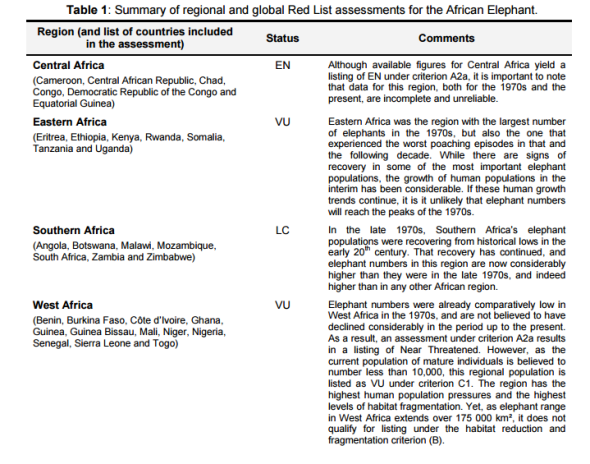 Image: table of assessments for the African Elephant
Image: table of assessments for the African Elephant
Whilst overlooking Viet Nam, CITES issued Thailand a direct warning in May, to quit the illegal ivory trade or CITES would impose immediate trade sanctions against the country. Why not Viet Nam, Japan or China?
Thailand ‘had’ until the end of March 2015 to take measures to shut down domestic trade in illegal elephant ivory or it will face trade sanctions under the Convention on the International Trade of Endangered Species (CITES), which met in Geneva last July. It must enact legislation to stem the trade of illegal African ivory in the country and implement a registration system for domestic ivory and ivory traders.
“WWF welcomes this decision and applauds the key role of the US delegation in holding Thailand accountable for their lack of progress since 2013 when it pledged to shut down its ivory market,” said Leigh Henry, WWF’s Senior Policy Advisor at the meeting. “Elephants across Africa and Asia are being slaughtered for ivory and illegal markets in countries like Thailand are allowing wildlife crime to flourish.”
Possible sanctions would impact Thailand’s trade in species covered by the convention, including ornamental plants, such as orchids, and reptile leather. Trade suspensions would, for example, prevent exports of orchids, which would result in a loss of more than $80.7 million in annual sales based on the 2013 value of this trade. The economic impact would be significant as the value of just some of Thailand’s CITES-listed export items was estimated at $157 million in 2012.
So we’ll now await for Cites response and if any trade sanctions will be imposed, IARF will also be calling on the same trade sanctions to be imposed on China, Japan and Viet Nam. After all the evidence is above for all and sundry to view - and this is just a mere 1% of evidence we hold on file of past and present illegal ivory trade.
Meanwhile a staggering ‘estimated’ one hundred Elephants are being slaughtered daily on the continent of Africa with some ten to fifteen killed a week in Asia. We plead with all our supporters 5.4 million of you, to demand Facebook now cleanses their server of all illegal ivory traders, shops, groups and individual buyers. We must continue to disrupt the trade, failing this we’ll never tackle the demand problem, and sadly Elephants will soon become nothing but a story or artifact within a dusty museum.
Thank you for reading.
I thank all members of the External Affairs Unit, International Animal Rescue Foundation Asia and the current operation leaders that have been fronting the online task force since 2010 known as #OperationTrojanHorse..
Dr Jose C. Depre
Chief Environmental Officer
Chief Executive Officer

